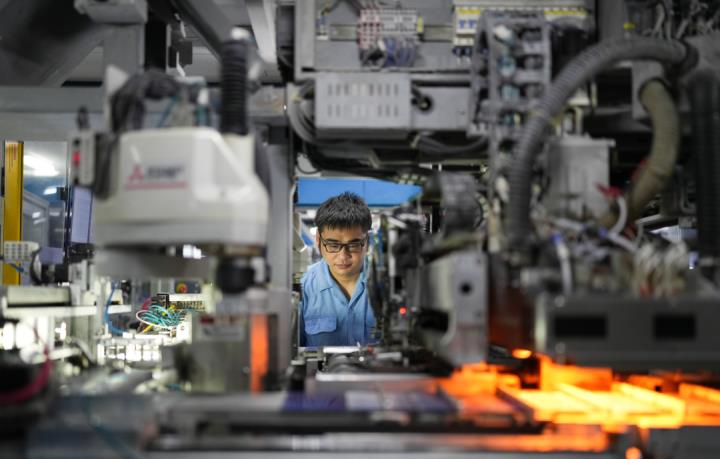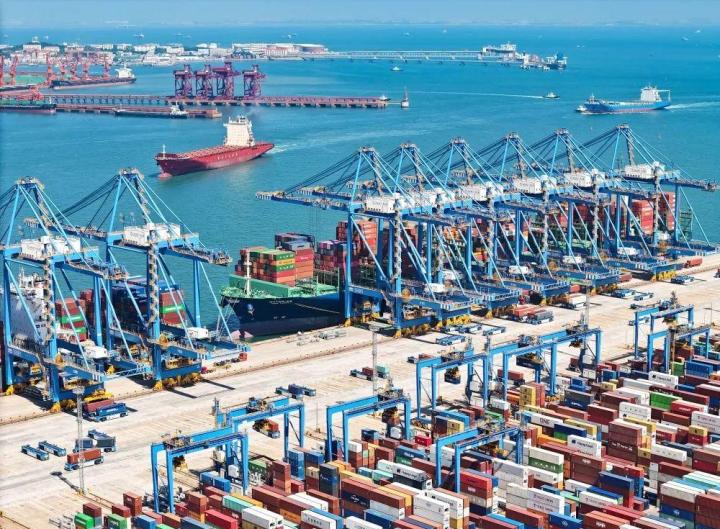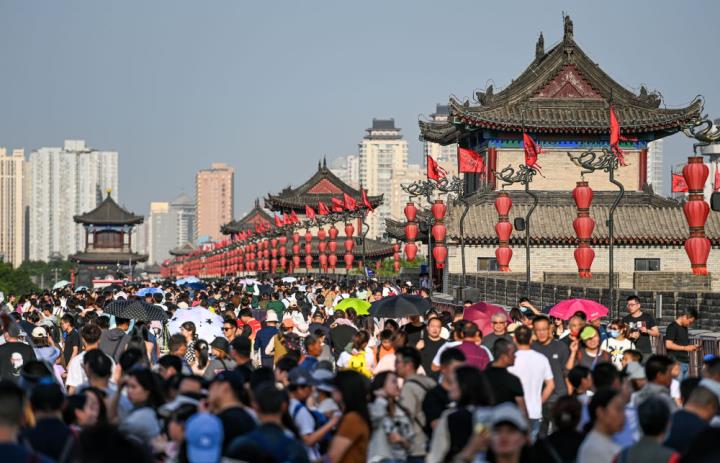In the past two days, the annual Central Economic Work Conference was held. In his important speech, General Secretary of the Supreme Leader comprehensively summarized the economic work in 2023, profoundly analyzed the current economic situation, and systematically deployed the economic work in 2024.
How to understand this year’s economic situation and see through next year’s development trend? Is it "seeing flowers in the fog" or "watching the fire from the hole"? Today, let’s find out from six perspectives.

Zhejiang Gongyuan New Energy Technology Co., Ltd. in Huangyan, Taizhou, the staff is operating a fully automatic welding machine to produce solar cells. Source: Xinhua News Agency
First, overall, the upward trend is a wave curve.
China’s economy is huge and involves a wide range. If you want to understand it correctly, you must not make a hasty conclusion by only a few indicators. There are many complex variables hidden behind it, which need us to consider all aspects comprehensively.
For example, production and supply have steadily picked up. Since the beginning of this year, China’s agricultural production situation has been good, and the national grain harvest has been bumper again. This is the ninth consecutive year that China’s grain output has remained above 1.3 trillion Jin. In addition, in industry and service industry, the growth trend is equally good. In the first 10 months of this year, the added value of industrial enterprises above designated size increased by 4.1% year-on-year, and the production index of service industry increased by 7.9%. It is worth mentioning that scientific and technological innovation, a "key variable", is also building a strong momentum for the high-quality development of China’s economy.
Maybe you will ask, why does Moody’s, an international rating agency, downgrade the outlook of China’s sovereign credit rating when the economy is developing so well? If we look at the rating, we can’t just look at Moody’s family. Recently, many international organizations and international commercial organizations have raised China’s economic growth expectations and cast a "vote of confidence" for China’s economy.
For example, JPMorgan Chase raised its forecast for China’s economic growth from 5% to 5.2%, Morgan Stanley from 4.8% to 5.1%, and Citigroup from 5% to 5.3%. In addition, up to now, the heads of global business giants such as Microsoft, NVIDIA, Tesla and Louis Vuitton have visited China one after another to seek cooperation opportunities, and they are optimistic about the prospects of China’s economic development. The development trend of China’s economy is just like a wave-like rising curve. For ourselves, it is even more necessary to have a firm belief, from which we can see the resilience and potential of development.
Second, personally, why do some people feel inconsistent with macro data?
In the first three quarters of 2023, China’s total GDP was 91,302.7 billion yuan, a year-on-year increase of 5.2% at constant prices; In the first eleven months, the national consumer price index rose by 0.3% year-on-year & hellip; … It can be said that from the data point of view, China’s economic operation continues to improve, and globally, it belongs to the first echelon of high growth.
But despite this, many people feel that business is getting harder and harder, jobs are getting harder and harder to find, making money is getting harder and harder, and money is getting more and more afraid to spend. Why?
On the big side, we must see that China’s economy has passed the previous stage of high-speed growth and turned into a stage of high-quality development, and it must face a long period of structural adjustment. For example, "new quality productivity" represented by new energy vehicles and photovoltaic industry is rising rapidly, while the growth rate of "traditional productivity" represented by real estate and its related industries is slowing down. This structural adjustment will inevitably bring some pains, especially when the growth kinetic energy of the former is not enough to cover the gap caused by the adjustment period, which will affect some people’s income and quality of life to some extent.

SAIC MG brand cars and new energy vehicles waiting to be shipped to Australia at Shanghai Waigaoqiao Haitong Automobile Terminal Source: Xinhua News Agency
From a small point of view, compared with the macro structural adjustment and economic growth, the individual’s experience of economic development is more subtle, and the people mainly feel economic development through daily life. There is a certain asymmetry between the comprehensiveness of macro indicators and the dispersion of micro feelings.
For example, it is normal that there is a certain deviation between the change of CPI and residents’ perception of price changes. The CPI data published by the National Bureau of Statistics is an average comprehensive index, which reflects the price trend of many commodities and services, but what ordinary people often feel every day is the price change of a single variety.
Coupled with the superposition of factors such as communication technology, ordinary people’s cognition of economic development has been affected to some extent. For example, the changing situation of the stock market, the adjustment and transformation of the Internet industry, and so on, have set off a storm of public opinion on the Internet from time to time, inevitably amplifying the public’s anxiety.
Third, historically, it is in a critical period of climbing over the ridge.
For China’s economy, the Supreme Leader General Secretary once made an image metaphor, "China’s economy is a sea, not a small pond".
Looking back on the course along the way, China’s economy is indeed as magnificent as the sea. Small winds and small waves, wind and rain are the norm, and big winds and waves sometimes occur. But every time after overcoming the crisis, it can always glow with more vigorous vitality. For example, in the Asian financial crisis in 1998, China’s economy withstood tremendous pressure and adopted multiple strategies to tide over the crisis smoothly, which suddenly attracted the attention of the whole world; In the international financial crisis in 2008, China’s economy once again showed a stable and far-reaching side of travel. After that crisis, China has also become one of the most important economies in the world.
At present, geopolitics, century epidemic and global inflation have also brought unprecedented challenges to China’s economy, but judging from the "hard core report card" of China’s economic difficulties, we should also remain confident.
As General Secretary of the Supreme Leader said, "When is there no difficulty? One by one, year after year, year after year, the Chinese nation has been like this for more than 5000 years. The key to climbing the hill is to boost confidence. " Now is the time for China’s economy to climb the hill and break through the barrier, and it will inevitably encounter some fluctuations and twists and turns, but at the same time, it is also honing itself. After this hurdle, the next journey will surely be sunny.
Fourth, dialectically, the crisis is organic and the crisis can turn around.
Objectively speaking, China’s economy is wading across the river, and it is always in new development and changes, whether facing opportunities or challenges.
Looking at China, the problem of insufficient development imbalance is still outstanding, the deep-seated contradictions in the reform and development are intertwined, and there are still security risks in the fields of food, energy and finance. China’s economy still needs to overcome difficulties.
Looking at the world, influenced by many factors such as the Russian-Ukrainian conflict and the Palestinian-Israeli conflict, the world economy is moving forward in a stumbling way. Although the direct impact of the century epidemic has gradually faded, its deep impact continues. Coupled with the counter-current, protectionism and unilateralism of economic globalization, the external pressure on China’s economic development has increased.
In addition, some western media use cognitive warfare to sing down China’s economy or empty China’s economy, clamoring for the so-called "China’s economic collapse theory" and "risk removal theory", ignoring the facts, making things out of nothing, and confusing people, in an attempt to disturb the judgments, expectations and confidence of all walks of life in China’s economy.
But as the old saying goes, danger is organic, and danger can turn around. History has proved more than once that the crisis is not only the cause of inducing the decline of the holdout countries, but also an opportunity to help the emerging countries become stronger. When we have mastered the skills of accurately recognizing changes, responding scientifically and actively seeking changes, and capturing and creating opportunities from crises, difficulties will be solved one by one, and problems will be broken one by one, thus "jumping up" and overtaking in corners and changing lanes will be realized.

China (Shandong) Pilot Free Trade Zone Qingdao Area Source: Xinhua News Agency
5. In the long run, the next "China" will be China.
Economic development is a spiraling process. We should not only look at the current "shape", but also look at the long-term "potential".
Identify the general trend. In the changing times, being strong is the last word. General Secretary of the Supreme Leader pointed out: "Our greatest opportunity is our continuous development and growth." After the founding of New China, especially since the reform and opening-up, our party has led the people to create a miracle of rapid economic development and long-term social stability, which is rare in the world, and provided the greatest confidence for China’s economic stability.
Keep the trend right. Among the "big classes" in the world, China’s economy continues to pick up, and it is still one of the strongest engines of global growth. According to the latest report, China’s economic contribution to global economic growth will reach one third this year. Recently, under the background of multiple uncertainties in the global economy, international institutions have intensively raised China’s economic growth expectations, which is the best proof.
Inspire the advantage. Practically speaking, China’s economic development still has many favorable conditions and supporting factors. For example, the dynamic advantages brought by the continuous deepening of reform and opening up, the institutional advantages of the socialist market economy, the demand advantages of the super-large-scale market, the complete supply advantages of the industrial system, and the talent advantages of a large number of high-quality workers and entrepreneurs, etc., all of which are the strong endogenous power and potential of China’s economic development.
China has strong economic resilience, sufficient potential and wide room for manoeuvre. The fundamentals of long-term improvement have not changed and will not change. Insisting on doing your own thing well and making yourself grow and develop continuously is the "ballast stone" and "reassurance" to deal with all risk challenges.

Since the beginning of this year, the domestic cultural tourism market has been booming. The picture shows tourists visiting the Xi’ an City Wall Scenic Area. Source: Xinhua News Agency
6. Strategically speaking, "strive for progress in stability, promote stability by progress, establish first and then break"
On December 8th, the Political Bureau of the Communist Party of China (CPC) Central Committee held a meeting, which clearly emphasized that next year we should adhere to the 12-word policy tone of "striving for progress while maintaining stability, promoting stability through progress, and establishing before breaking".
"Striving for progress in stability" is the general tone. As we all know, this is both a basic method and a successful experience. To put it bluntly, it is to insist on the word "stability". For a large-scale economy like our country, the annual increase in GDP is equivalent to the annual economic aggregate of a medium-sized country, so stability is overwhelming, and "stability" is also the biggest "progress". This also requires us to improve our ability to cope with extreme situations with bottom-line thinking and extreme thinking, and ensure high-quality development with high-level security.
"Promoting stability through progress" and "striving for progress through stability" are a pair of dialectical relations, which emphasize the relationship between "stability" and "progress". Highlighting "promoting stability through progress" is the component that further highlights "progress", emphasizing fully stimulating the advantages and vitality of all aspects, accelerating the construction of a new development pattern, and always being invincible in the fierce market competition and big country game.
"Stand first and then break" does not mean that there is no "break" in the process of "stand first", but "stand" is the main contradiction and the main aspect of contradiction. Just like in land acquisition and demolition, high-quality housing is built first and then demolished, from "waiting for a house" to "waiting for a house", so that not only the difficulty coefficient of demolition will be greatly reduced, but also the unstable factors of demolition will be controlled. It can be seen that in the future, in the transformation of old and new kinetic energy, the sublation of old and new mechanisms, and the coordination of pilot promotion, "standing first" will not be "broken for the sake of breaking".
Of course, in the final analysis, the most important thing at present is to stabilize expectations and strengthen confidence, which is also the top priority and key to doing a good job in economic work. Grasping this "bull’s nose" can form a joint force to promote high-quality development.
关于作者